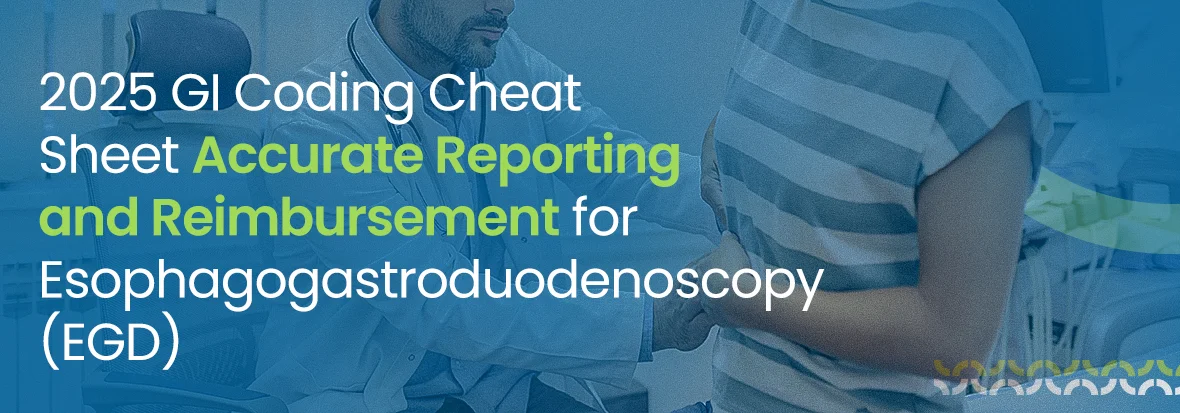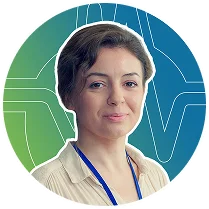The American Society for Gastrointestinal Endoscopy (ASGE) ensures that gastroenterology practices have effective methods for accurate reporting and fair reimbursement for procedures, tests, and visits.
To help healthcare providers handle GI-specific coding, ASGE has created coding cheat sheets. These sheets offer a concise overview, supporting practices in accurate coding and reimbursement for 2025.
What is Esophagogastroduodenoscopy (EGD)?
Esophagogastroduodenoscopy (EGD) is an endoscopic procedure used to examine the upper gastrointestinal tract, including the esophagus, stomach, and duodenum. CPT codes for EGD (43235-43259) describe the services performed during this procedure.
CPT Codes for Esophagogastroduodenoscopy
| CPT Code | Description |
|---|---|
| 43235 | Esophagogastroduodenoscopy, flexible, transoral; diagnostic, including collection of specimen(s) by brushing or washing, when performed |
| 43236 | Esophagogastroduodenoscopy, flexible, transoral; with directed submucosal injection(s), any substance |
| 43237 | Esophagogastroduodenoscopy, flexible, transoral; with endoscopic ultrasound examination limited to the esophagus, stomach, or duodenum, and adjacent structures |
| 43238 | Esophagogastroduodenoscopy, flexible, transoral; with transendoscopic ultrasound-guided intramural or transmural fine-needle aspiration/biopsy(s), including endoscopic ultrasound examination limited to the esophagus, stomach, or duodenum, and adjacent structures |
| 43239 | Esophagogastroduodenoscopy, flexible, transoral; biopsy, single or multiple |
| 43240 | Esophagogastroduodenoscopy, with transmural drainage of pseudocyst (includes placement of transmural drainage catheter(s)/stent(s), when performed, and endoscopic ultrasound, when performed) |
| 43241 | Esophagogastroduodenoscopy, flexible, transoral; insertion of intraluminal tube or catheter |
| 43242 | Esophagogastroduodenoscopy, flexible, transoral; with transendoscopic ultrasound-guided intramural or transmural fine-needle aspiration/biopsy(s) (includes endoscopic ultrasound examination of the esophagus, stomach, and either the duodenum or a surgically altered stomach where the jejunum is examined distal to the anastomosis) |
| 43243 | Esophagogastroduodenoscopy, flexible, transoral; injection sclerosis of esophageal/gastric varices |
| 43244 | Esophagogastroduodenoscopy, flexible, transoral; band ligation of esophageal/gastric varices |
| 43245 | Esophagogastroduodenoscopy, flexible, transoral; with dilation of gastric/duodenal stricture(s) (e.g., balloon, bougie) |
| 43246 | Esophagogastroduodenoscopy, flexible, transoral; with directed placement of percutaneous gastrostomy tube |
| 43247 | Esophagogastroduodenoscopy, flexible, transoral; with removal of foreign body(s) |
| 43248 | Esophagogastroduodenoscopy, flexible, transoral; insertion of guide wire followed by passage of dilator(s) through esophagus over guide |
| 43249 | Esophagogastroduodenoscopy, flexible, transoral; transendoscopic balloon dilation of esophagus (<30 mm) |
| 43233 | Esophagogastroduodenoscopy, flexible, transoral; with dilation of esophagus with balloon (30 mm diameter or larger) (includes fluoroscopic guidance, when performed) |
| 43250 | Esophagogastroduodenoscopy, flexible, transoral; with removal of tumor(s), polyp(s), or other lesion(s) by hot biopsy forceps |
| 43251 | Esophagogastroduodenoscopy, flexible, transoral; with removal of tumor(s), polyp(s), or other lesion(s) by snare technique |
| 43252 | Esophagogastroduodenoscopy, flexible, transoral; with optical endomicroscopy |
| 43253 | Esophagogastroduodenoscopy, flexible, transoral; with transendoscopic ultrasound-guided transmural injection of diagnostic or therapeutic substance(s) (e.g., anesthetic, neurolytic agent) or fiducial marker(s) (includes endoscopic ultrasound examination of the esophagus, stomach, and either the duodenum or a surgically altered stomach where the jejunum is examined distal to the anastomosis) |
| 43254 | Esophagogastroduodenoscopy, flexible, transoral; with EMR (endoscopic mucosal resection) |
| 43255 | Esophagogastroduodenoscopy, flexible, transoral; with control of bleeding, any method |
| 43256 | Deleted. Use 43266 |
| 43266 | Esophagogastroduodenoscopy, flexible, transoral; with placement of endoscopic stent (includes pre- and post-dilation and guide wire passage, when performed) |
| 43257 | Esophagogastroduodenoscopy, flexible, transoral; with delivery of thermal energy to the muscle of lower esophageal sphincter and/or gastric cardia, for treatment of gastroesophageal reflux disease |
| 43258 | Deleted. Use 43270 |
| 43270 | Esophagogastroduodenoscopy, flexible, transoral; with ablation of tumor(s), polyp(s), or other lesion(s) (includes pre- and post-dilation and guide wire passage, when performed) |
| 43259 | Esophagogastroduodenoscopy, flexible, transoral; with endoscopic ultrasound examination, including the esophagus, stomach, and either the duodenum or a surgically altered stomach where the jejunum is examined distal to the anastomosis |
Simplify your endoscopy billing with expert support
Modifier 52: Reduced Services in Gastroenterology Procedures
Modifier 52 is used to report a partially reduced or incomplete procedure performed at the discretion of the gastroenterologist or physician. This modifier applies when the intended service is not fully completed, but the decision to stop is not based on patient risk.
When to Use Modifier 52:
Modifier 53 is appended when a diagnostic or surgical procedure is started but discontinued due to unforeseen complications or extenuating medical circumstances that place the patient’s health at risk. It specifically applies after anesthesia has been administered.
When to Use Modifier 53:
Use this modifier when a gastroenterology procedure like a colonoscopy is halted for patient safety, such as due to a sudden drop in blood pressure or other serious medical event.
Scenario Example – Modifier 53 in GI Endoscopy:
During a colonoscopy performed under anesthesia, the patient experiences a severe drop in blood pressure. To protect the patient’s safety, the gastroenterologist immediately discontinues the procedure.
Correct Coding Format:
Use CPT Code 45378 with Modifier 53 to indicate the procedure was started but not completed due to risk.
Example: 45378-53 – Colonoscopy discontinued after anesthesia due to patient complication.
Modifier 53: Discontinued Procedure Due to Medical Risk
This modifier indicates that a surgical or diagnostic procedure was started but discontinued due to extenuating circumstances or those that threaten the patient’s well-being. It’s applicable when a procedure is terminated due to unforeseen complications that pose a risk to the patient after anesthesia has been administered. This kind of scenario is a common cause of claim denials if not coded properly. Read more in our Denials and Rejections in Medical Billing guide. For instance, if a patient experiences a severe drop in blood pressure during a colonoscopy, leading the physician to halt the procedure, Modifier 53 should be used.
Scenario:
During a colonoscopy, the patient experiences a significant drop in blood pressure after anesthesia is administered. The physician halts the procedure to ensure the patient’s safety.
- How to Use: Attach Modifier 53 since the procedure was stopped due to a medical emergency that risked the patient’s well-being.
- Example: Code as 45378-53 (Diagnostic colonoscopy, discontinued due to patient condition).
Modifier XS: Separate Structure
This modifier denotes a service that is distinct because it was performed on a separate organ or structure. It’s used to indicate that a procedure was carried out on a different anatomical area than another procedure performed on the same day. Correct usage of XS modifier helps ensure full reimbursement for same-day multi-procedure cases, as explained in our Top 5 RCM Challenges in Healthcare.
Scenario:
A patient undergoes an upper gastrointestinal endoscopy (EGD) for stomach pain and a separate colonoscopy for rectal bleeding on the same day. These procedures target different anatomical structures.
- How to Use: Use Modifier XS to indicate that the procedures are distinct because they were performed on separate body areas.
- Example:
- 43235 (EGD)
- 45378-XS (Colonoscopy on a separate structure)
Modifier XU: Unusual Non-Overlapping Service
This modifier is used when a service is distinct because it does not overlap usual components of the main service. It indicates that the procedure performed is separate and not typically included in another service provided on the same day.
Scenario:
A physician performs a colonoscopy and removes a polyp. During the same session, an unrelated biopsy is taken from a different site for a different medical reason.
- How to Use: Use Modifier XU to indicate the biopsy is a distinct and unusual service that doesn’t overlap with the polypectomy.
- Example:
- 45385 (Colonoscopy with polypectomy)
- 45380-XU (Colonoscopy with biopsy at a different site)
Modifier 73: Discontinued Out-Patient Hospital/Ambulatory Surgery Center (ASC) Procedure Prior to the Administration of Anesthesia
This modifier applies when a procedure is terminated after the patient has been prepared for surgery but before anesthesia has been administered. It’s used by facilities to report discontinued procedures due to extenuating circumstances that do not involve patient risk.
Scenario:
A patient scheduled for an outpatient endoscopy develops severe anxiety and refuses the procedure after being prepped but before anesthesia is administered.
- How to Use: Append Modifier 73 because the procedure was discontinued before anesthesia due to extenuating circumstances.
- Example: 43235-73 (EGD, discontinued before anesthesia)
Modifier 74: Discontinued Out-Patient Hospital/Ambulatory Surgery Center (ASC) Procedure After Administration of Anesthesia
This modifier is used when a procedure is terminated after anesthesia has been administered. It’s applicable when a procedure is discontinued due to unforeseen circumstances after the patient is under anesthesia, and it’s reported by the facility.
Scenario:
During a colonoscopy under anesthesia, the physician encounters a large mass obstructing the colon, making it unsafe to continue. The procedure is stopped.
- How to Use: Attach Modifier 74 because anesthesia was administered, and the procedure was terminated due to unforeseen complications.
- Example: 45378-74 (Colonoscopy, discontinued after anesthesia)
Preventive Services Modifiers:
Two specific modifiers used in the preventive services are:
- Modifier 33: Used for preventive services. When a screening procedure is converted to a diagnostic or therapeutic procedure for commercial insurance carriers, Modifier 33 should be appended to the CPT code. Our Medical Billing Services help ensure that preventive and diagnostic coding transitions are handled accurately, especially for Medicare claims.
- Modifier PT: Used for Medicare patients. When a screening colonoscopy is converted to a diagnostic or therapeutic procedure, Modifier PT is appended to indicate that the service began as a preventive service but changed based on findings during the procedure.
Scenario:
A Medicare patient undergoes a screening colonoscopy. A polyp is found and removed during the same session.
- How to Use: Append Modifier PT to signify that the procedure began as a screening but turned diagnostic/therapeutic.
- Example: 45385-PT (Colonoscopy with polypectomy, initially preventive for Medicare)
The Bottom Line
It’s essential to use these codes and modifiers accurately to reflect the specific circumstances of each procedure. Always refer to the most recent coding guidelines and payer policies, as definitions and applications can evolve over time.

